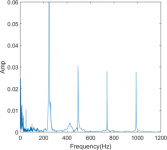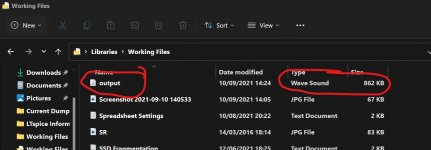There is also one big component that affects an amplifiers THD performance, and it's not one thats easily changed...
The PCB layout.
The PCB layout.
WOW ,i guess for at least now things stay as they are untill my knowledge is of a level of requirement(that may be never 😉) cheers for that though, i find it all very interesting, even if i only understand part of it all.🙂Since, an amplifier most probably uses negative feedback, it is very tricky to modify its circuit without affecting stability. Sometimes, a swap of an output transistor with a more accessible and modern one, results in a vigorously oscillating amplifer which can destroy itself in half a minute. Therefore, any modifications, irrespective of how small they are, have to be done, keeping in mind, that an amplifier must remain well behaved, such that, it does not start oscillating on its own.
To improve the distortion figure there are various standard steps which can offer some hope, although great caution has always to be exercised.
a) current sources to feed the constant current to an input stage's differential pair
b) current mirrors as the load of input differential pairs.
c) a Miller capacitor at the VAS. This is a must and careful selection can have appreciable lowering of distortion
d) a constant current source as the load for the VAS
e) biasing the driver stage so that the output stage conducts an idle current of about 10mA per power transistor. This only applies to Class AB amplifiers.
f) Adding a buffer stage between the VAS and driver stage. The buffer, being an emitter follower, should have a very minimal impact on the VAS, thereby causing a very minimal VAS disruption. This method is usually only reserved for very high power PA amplifiers.
The following apply as measures to protect an amplifier from injection of foreign signals:
g) using extra power supply filtering for the input stage and VAS
h) protecting the input stage from stray magnetic fields from the mains transformer
i) using a super regulator to completely eliminate the power supply ripple
j) using a star earth connection for the input stage
k) using a low resistance, around 10R, between the power ground and signal ground. This tames down earth loops.
Note:
Thanks to Mooly and many others, I learnt all these thanks to these fora. Electronics is an elusive technology, experience and a deep personal humility to admit to oneself past errors, are assets without which, improvement is next to impossible.
The PCB is actually a collection of capacitors, inductors and low value resistors. Adjacent tracks behave like transformers albeit with very low mutual inductances. In radio frequency applications, tracks also behave like resonators and transmission lines.There is also one big component that affects an amplifiers THD performance, and it's not one thats easily changed...
The PCB layout.
The charge on electrons and protons makes electronic currents extremely richly behaved.
so could an existing amplifier design be bettered by better quality components?, or simple design changes, or is each amplifier unit already as good as it can be without major changes?
So called better quality parts make little to no difference tbh. Design changes and tweaks can subtly alter things but it is really the basic circuit topology that sets how it is going to sound.
that wasnt done in spice though was it? you can very MUCH hear the difference
the third one, sounds quite dull in comparison to the first,which is too bright and has a sharpness to its edges, almost grating
It certainly was done is LTspice 🙂 You can even play a music file into a simulation and record the output.
THD isn't a very useful measurement in that it doesn't necessarily correlate well with audibility. HD2 can be up to 5-10% before hitting the threshold of audibility, while HD5 or HD7 might be audible at 0.1% (thumb-suck), while their magnitudes are weighted equally.
So called better quality parts make little to no difference tbh. Design changes and tweaks can subtly alter things but it is really the basic circuit topology that sets how it is going to sound.
It certainly was done is LTspice 🙂 You can even play a music file into a simulation and record the output.
realy how do you do that?
could you run music off your own amp and analize it?
THD isn't a very useful measurement in that it doesn't necessarily correlate well with audibility. HD2 can be up to 5-10% before hitting the threshold of audibility, while HD5 or HD7 might be audible at 0.1% (thumb-suck), while their magnitudes are weighted equally.
What is a more important figure of merit? IMD? Noise measurements related to the forest of products produced?
I ask and wonder because of the attached spectrum from a piano note. There is very high harmonic content already from the bare instrument. (Is the same is true of many (most?) instruments?) How could one hear a tiny addition to the already present much higher amplitude harmonics? (2nd harmonic in that image is only 30 dB down?)
Is the problem more from products which are not found in the musical scale and/or normal spectra of the instrument? Is that what sounds bad? Along with noise?
Attachments
Good 'innit 🙂
Although the files are long gone you might like looking at this:
Welcome to the (virtual) listening room.
This attached file is the one I used today and it records 10 seconds of audio (because the sim runs for 10 seconds).
Look at the spice directive:
It has to be exactly as written but you can alter the file path. Working Files is just a folder in my Documents. Output.wav is what you want to call the file. It must use the .wav extension. It must be 16 44.1k (16 bit 44.1kHz) and V(Vout) is the name of the point on the simulation you want to capture the audio from. it is the voltage at point Vout on the sim.
Although the files are long gone you might like looking at this:
Welcome to the (virtual) listening room.
This attached file is the one I used today and it records 10 seconds of audio (because the sim runs for 10 seconds).
Look at the spice directive:
Code:
.wave "C:\users\Karl\Documents\Working Files\Output.wav" 16 44.1k V(Vout)It has to be exactly as written but you can alter the file path. Working Files is just a folder in my Documents. Output.wav is what you want to call the file. It must use the .wav extension. It must be 16 44.1k (16 bit 44.1kHz) and V(Vout) is the name of the point on the simulation you want to capture the audio from. it is the voltage at point Vout on the sim.
Attachments
So when I run that sim which I did a couple of minutes ago it produce this.
Getting it to work with a music file requires you to have a .wav file of the music on your PC and you have to alter the input voltage source of the sim to use that file.
Doing a stereo set up is a bit more involved because you have to duplicate the amplifier (easy in LT) and also split the .wav file into stereo and that is where Audacity comes into its own.
These were valid notes I made at the time.
Getting it to work with a music file requires you to have a .wav file of the music on your PC and you have to alter the input voltage source of the sim to use that file.
Code:
Settings for importing and exporting .wav files into LTspice.
1/Set the voltage input source by holding down CTRL and right clicking the source.
2/In the 'Value' field enter:
wavefile=nameoffile.wavDoing a stereo set up is a bit more involved because you have to duplicate the amplifier (easy in LT) and also split the .wav file into stereo and that is where Audacity comes into its own.
These were valid notes I made at the time.
Code:
NOTE...
In creating stereo files (split to mono) in Audacity something odd happens. The right channel .wav file, while perfect in media player, will not function in LTspice. The final output from the circuit under test is just silence.
To correct this, first split the tracks and export the left file as normal. Now undo (use edit>undo) and now reverse the tracks. Again export the left channel (which is now the right of course). That seemed to work.Attachments
Good 'innit 🙂
Although the files are long gone you might like looking at this:
Welcome to the (virtual) listening room.
This attached file is the one I used today and it records 10 seconds of audio (because the sim runs for 10 seconds).
Look at the spice directive:
It has to be exactly as written but you can alter the file path. Working Files is just a folder in my Documents. Output.wav is what you want to call the file. It must use the .wav extension. It must be 16 44.1k (16 bit 44.1kHz) and V(Vout) is the name of the point on the simulation you want to capture the audio from. it is the voltage at point Vout on the sim.Code:.wave "C:\users\Karl\Documents\Working Files\Output.wav" 16 44.1k V(Vout)
ill give it a go
whos karl?
Very good questions. Yes, it is a natural line of thinking as to the audibility of harmonic distortion when musical instruments create a substantial "forest" of harmonics to begin with, as you say.What is a more important figure of merit? IMD? Noise measurements related to the forest of products produced?
I ask and wonder because of the attached spectrum from a piano note. There is very high harmonic content already from the bare instrument. (Is the same is true of many (most?) instruments?) How could one hear a tiny addition to the already present much higher amplitude harmonics? (2nd harmonic in that image is only 30 dB down?)
Is the problem more from products which are not found in the musical scale and/or normal spectra of the instrument? Is that what sounds bad? Along with noise?
This is, I believe, the reason why it takes so much low-order HD to be audible, while higher-order HD is more audible as they seem to be naturally generated in smaller amplitude, typically.
Noise is not a good thing either, but if you can't hear the noise from your listening position (easy to test), then it's nothing to worry about. So I think that leaves the following to ponder:
- higher-order HD products (4/5/6/7/xxx) - although very high orders may be outside the limits of hearing anyway, e.g. a 5th order HD on a 5 kHz tone is 25 kHz
- IMD
- forms of linear distortion - resonances / ringing - more on the speaker side though
- Home
- Amplifiers
- Solid State
- Amplifier THD

